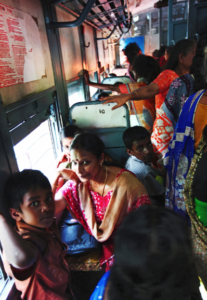Migrants’ ride: Long-distance trains like Coromandel Express are especially vital, they carry millions travelling for jobs
In 2017, GoI’s annual economic survey sprung a surprise. For long, the debate on migration within the country was headlined by the puzzling phenomenon that it was rather slow-paced. The decennial census, which represents a snapshot at the end of every decade, didn’t quite capture what was happening. The economic survey used unreserved railway travel as a proxy for economic migration between 2011 and 2016 and concluded that annual average inter-state migration was close to nine million, way more than what the census had captured. Buried in that dataset was another message: trains have a bigger impact than what’s conventionally measured.

Trains are the lifeline for a bulk of India’s poorer economic migrants. Their ability to move and improve their economic prospects have a positive impact on their home states through remittances. GoI’s annual jobs data in 2020-21 (PLFS) tried to gauge the cause for migration. For men, an overwhelming 43% of migrants said it was linked to employment. While the railway data showed that traditional magnets for migrants such as NCR, Maharashtra and Gujarat continue to exert a strong pull, the emerging flows are from north and east to the south. Long distance routes such as the one served by Coromandel Express play a vital role here.
When seen in isolation, railway finances are an example of messy cross-subsidisation between different revenue sources, common to other government-controlled areas such as electricity distribution. However, this view understates the larger economic impact that railways have by providing a cost-effective mode of transport across long distances. If anything, some of these long-distance migrant routes are underserved. For example, economic historian Chinmay Tumbe estimated that Kerala, before the pandemic, had about two million migrants from UP and Bihar.
In politics, language is a combustible issue. However, when it comes to migration, the economic survey pointed out that language is not a barrier. In that sense, railways play a unifying role that is rarely acknowledged. Indian Railways has received considerable budgetary support in the last few years. This positive development needs to be backed by reorienting priorities within the railways. Enhancing service in ‘migrant corridors’, backed by a greater attention to safety will pay off in ways that cannot be captured by looking at railway finance in isolation. India’s economic performance will be influenced by the efficiency of its rail network. And its safety.